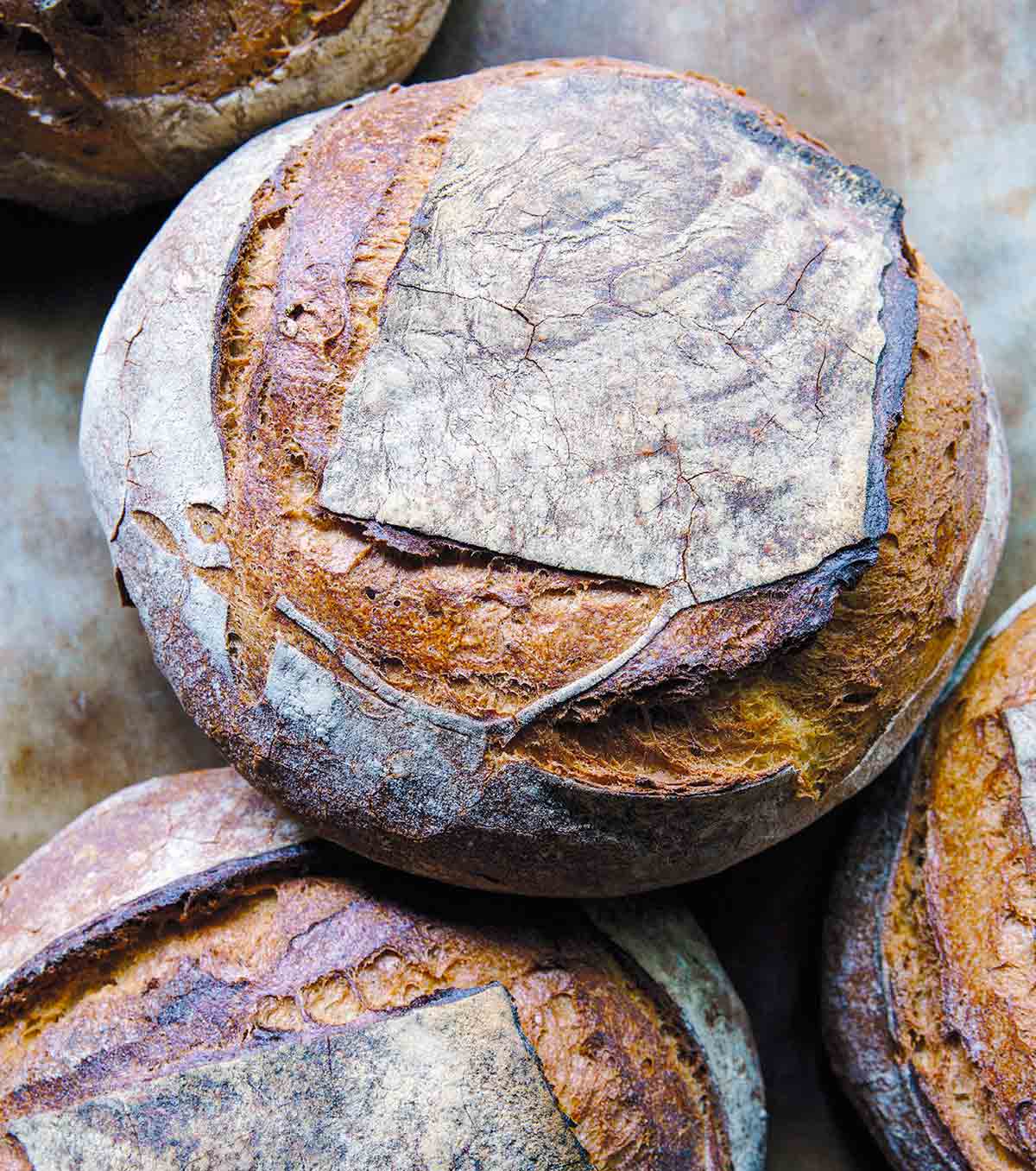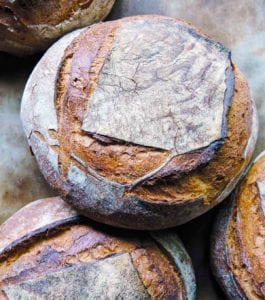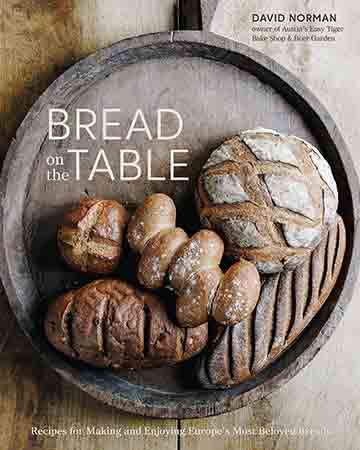
Like many of the best things in life, this pain au levain cannot be rushed. However, the distinct sourdough tang, tender crumb, and rustic elegance of this homemade bread is worth the wait. Well worth it.–Angie Zoobkoff
Want to Save This?

Pain au Levain
Equipment
- Bowl scraper or bench scraper; baking stone
Ingredients
For the wake-up feed
- 7 ounces mature sourdough starter (levain), made at least 1 week in advance
- 1 1/2 cups (7 oz) all-purpose flour
- 1/2 cup (4.2 oz) lukewarm water (90°F | 32°C)
For the final feed
- 5.8 ounces sourdough starter (levain)
- 3/4 cup (5.8 oz) all-purpose flour
- 1/3 cup (2.8 oz) water
For the dough
- 5 cups plus 2 1/2 tablespoons (23.3 oz) all-purpose flour, plus more for dusting
- 1 1/2 cups (6 oz) whole spelt flour
- 5 tablespoons (1.2 oz) whole rye flour
- 1 tablespoon plus 2 teaspoons (1 oz) salt
- 3 cups (24 oz) water
- Rice flour, semolina, or all-purpose flour for dusting
Instructions
Wake up the starter
- If you have a starter that you’ve been maintaining but that isn’t active, place the starter in a clean bowl and mix in the flour and water by hand, stirring and blending with your fingers, until well incorporated. Cover with a tea towel and let ferment at room temperature for 8 to 10 hours.
If your starter is already active, proceed to step 2.
Give the starter a final feed
- About 3 hours before you want to make your bread dough, place the starter in a clean bowl and mix in the flour and water by hand, stirring and blending with your fingers, until well incorporated. Cover with a tea towel and let ferment at room temperature for 3 hours. You will use all of the starter (levain) from this feed in the dough.
Make the dough
- In a large bowl, combine the all-purpose, spelt, and rye flours, and the salt. Divide the starter into 6 pieces and scatter them on top of the flour. Make a well in the center of the flour and add the water.
- Using your fingers, start to blend the water and starter into the flour with your fingers. As the flour begins to absorb the water and the mixture starts to thicken, plunge both hands in and gently squeeze the dough. Work the water into the flour first since the starter is already hydrated. Then start to work the starter into the moistened flour as you squeeze. Work from the side of the bowl closest to you across to the other side, squeezing with both hands. Rotate the bowl a quarter turn and squeeze your way through the dough again. You will feel the dough starting to come together as a more cohesive mass as the water and starter become more fully incorporated. Use your bowl scraper from time to time to scrape the sticky dough from the sides of the bowl into the center.
- Keep rotating the bowl and squeezing the dough until everything is fully incorporated, 1 to 2 minutes. It will remain a shaggy and sticky mass. The dough should have a definite give but also some resistance and you should be able to feel a core when you squeeze it.
- Turn the dough onto an unfloured work surface, using the bowl scraper to get it all out of the bowl and scraping as much off your hands as you can.
☞ TESTER TIP: The dough will be very wet. This is normal for pain au levain. Resist the urge to add more flour.
- Starting with the edge of the dough closest to you, grab it with both hands, palms down, and pull it gently toward you. Stretch it up and flip it over the top of the dough mass by 2 or 3 inches (5 or 8 cm) and press it back into the surface of the dough. Grab the new edge closest to you and stretch it gently up and flip it over the top. Repeat this stretching and flipping of the dough 4 or 5 times, working your way to the far side of the mass. The stretches should be gentle enough not to tear the dough apart. As you continue this process, the dough will start to hold together better and be easier to stretch though it will still be very sticky.
- Scrape up the dough with a dough scraper, rotate it a quarter turn, and repeat the stretching and flipping through the dough mass 4 or 5 times for a total of 3 to 5 minutes. With each stretch and flip of the dough, you will feel it developing and becoming more cohesive and less sticky. When most of the dough holds together and pulls off the work surface as you stretch it, slide the dough scraper under it and gather it into a ball. The dough will not be fully developed yet and will still be a little sticky.
- Cup your hands around the bottom of the far side of the ball and pull it gently toward you, allowing the dough to grip the work surface, then move your hands to the left rotating the dough counterclockwise. Return your hands behind the dough and pull and rotate again 1 or 2 times. This will tighten the surface and help shape the dough into a smooth ball.
- Return the ball to the bowl with the smooth side up and let it rest for 15 minutes.
- On a lightly floured surface, place the dough smooth side down and gently press out the dough to flatten it into a round about 2 inches (5 cm) thick. Grab the edge closest to you and stretch it up and over the top of the dough, about 2/3 of the way to the opposite side and then press it into the surface. Grab the edge opposite you and stretch and fold it toward you over the first fold, about 2/3 of the way to the closest edge, and press it into the surface. Rotate the dough a quarter turn and repeat 2 more folds, one away from you and one toward you.
- Turn the dough over so the seam side is down. Form a ball by cupping your hands around the bottom of the far side of the dough and pulling it toward you, rotating the dough counterclockwise. Repeat once or twice to form a ball. The dough will be more developed and will stretch tighter than before. Be careful not to stretch it too tight; if the surface starts to tear, stop tightening. Return the ball to the bowl, smooth side up, and let rest for 15 minutes.
- Repeat this stretching and folding 3 times at 15-minute intervals for a total of 4 folds over an hour.
- After the final fold, return the ball to the bowl smooth side up, cover with a tea towel or plastic wrap, and let sit in a warm, draft-free place until the dough has doubled in volume and feels airy when gently touched, about 1 hour.
- Turn out the dough on a lightly floured surface, smooth side down. Press it gently to flatten a bit until it is about 2 inches thick. It’s okay to press out some of the gases, but do it gently and not too thoroughly. Grabbing the edge opposite you, stretch the dough and fold it over the top, about halfway toward you. Gently press the dough down, then stretch the edge closest to you and fold it over the first fold. Press it in gently. Rotate the dough a quarter turn and repeat 2 more folds, one away from you and one toward you.
- Turn the dough over so the seam side is down. Cup your hands behind the dough and gently pull it toward you to stretch the surface. At the same time, move your hands to the left, rotating the dough counterclockwise about a quarter turn, rounding it. Repeat once or twice to form a ball. Return the ball to the bowl with the smooth side up and cover again with a tea towel or plastic wrap until it doubles in volume again, anywhere from 30 minutes to 2 hours, depending on the warmth of your kitchen.
- On a lightly floured surface, place the dough smooth side down and use your scraper to divide the dough into 2 equal pieces.
- Gently press 1 piece of the dough to flatten it into a rough circle about 1 inch (25 mm) thick. Grab the edge opposite you and stretch it up and over the top of the dough, about 2/3 of the way toward you. Gently press into the surface with the heel of your hand. Rotate the dough a quarter turn and grab the edge opposite you again, stretching and folding it over the first fold, about 2/3 of the way toward you, pressing it gently. Repeat two or three times until you have a loose ball shape and then turn the ball over so the seam side is down.
- Cup your hands behind the ball with your pinkie fingers and the sides of your hands on the table, then gently pull your hands toward you. At the same time as you are gently pulling, move your hands to the left, causing the ball to rotate counterclockwise about a quarter turn. The dough should grip the table and the surface will tighten. Move your hands behind the ball again, pulling gently and rotating the ball. Cover with a tea towel and repeat with the second piece of dough. Let the dough rest for 15 to 20 minutes so the gluten relaxes a bit.
- Turn the first ball over so the smooth side is down and gently press the ball a bit. Stretch and fold the opposite edge about 2/3 of the way toward you and press into the dough with the heel of your hand. Rotate the dough a quarter turn and stretch and fold another flap about 2/3 of the way toward you over the first flap and press it in. Repeat 3 times and then turn the ball over so the seam side is down. Cup both hands behind the ball so that your pinkie fingers and the sides of your hands are touching the table and pull the dough ball toward you. At the same time, move your hands to the left so that the ball rotates counterclockwise about a quarter turn. Move your hands back behind the ball and repeat pulling and rotating the ball, stretching and tightening the surface of the dough. Keep rounding until you have a smooth, tight surface and a nice round shape, taking care not to pull so hard that the surface tears. Repeat with the second ball of dough.
- Evenly flour 2 bowls or proofing baskets with a light coat of flour. Invert the balls into the baskets so that the seam side is up.
- Preheat the oven to 500ºF (260°C) with a baking stone in the middle rack and steaming pan or cast-iron skillet on the lowest rack set below the stone.
- Cover the loaves with a towel and let rise until they feel lighter and full of air, 1 to 2 hours.
- Dust a peel or a rimless baking sheet with rice flour and turn out one of the proofed loaves onto the peel with the seam down close to the front edge of the peel.
- Using a funnel, carefully pour about 1⁄4 cup water into the cast iron skillet and quickly close the door. Let the steam settle for 30 seconds or so while you score the loaf.
☞ TESTER TIP: If you don’t have a funnel for getting water to your steam pan, fear not. Just open the oven door and pour the water into the pan as quickly as possible and close the door.
- Use a razor blade or sharp knife to evenly score the loaf with cuts about 1/8-inch (3-mm) deep.
- Open the oven and place the tip of the peel on the baking stone where you want the loaf to end. Leave room for the second loaf if the stone is large enough; center the loaf if it is not. Quickly pull the peel out from under the loaf, letting it drop onto the baking stone. Close the oven door immediately. If your stone can fit 2 loaves, quickly score the second loaf and place it onto the baking stone. If not, refrigerate the second loaf until the first is finished baking.
- Add 1 cup water to the skillet and quickly close the oven door. Reduce the oven temperature to 450ºF (232°C). Bake until the crust is a deep brown color and the loaf sounds hollow when it’s tapped on the bottom, about 35 minutes. If it still gives a heavy thud, return it to the oven for 5 to 10 minutes.
- Cool the bread on a wire rack before slicing.
Notes
Shop The Look
Love the look? Click to bring the LC Lifestyle into your home. 3 1/10 Quart Multi Bowl by Le Creuset 18-inch by 40-inch Turkish Tea Towel by Turkish Dowery
Nutrition
Nutrition information is automatically calculated, so should only be used as an approximation.
Recipe Testers’ Reviews
This is a beautiful sourdough bread. It does its final rise in the oven to form a crusty, nicely browned loaf. The flavor is certainly sourdough, but the taste is smooth and subtle. This bread will not overpower the remainder of the meal but will complement it beautifully.
I used my own starter for this bread and followed the directions to wake it up, give it a final feed, and build the bread. This is not a quick bread by any means. I began the first wake-up at 8 pm, started the final feed at 8 am, and took the loaves from the oven at 6 pm the next day. This is a bread that will not be rushed, and it will require your attention throughout the day. Make this on a day that you will be home doing other things.
It should be emphasized that the dough will initially be much too sticky to seem like a viable bread dough, but the texture transforms when it rests. I was sure this recipe was not going to work and had to refrain myself from adding more flour. DO NOT ADD MORE FLOUR. This recipe will work and work well.
Step 9 was the miracle step. After leaving the dough to rest for 15 minutes, it was finally a good bread dough consistency. The directions were clear in this step.
The last rise took 1 hour 15 minutes. The loaves were about double in size but still on the small side. I cooked each loaf for 35 minutes and they were perfectly done. Each loaf would have 8-10 hearty slices.
The instructions for this pain au levain recipe look daunting and long-winded. However, the recipe works as stated and if you are patient and follow the recipe, you get good bread which has a slightly sour taste and a crunchy crust. The bread had some big holes in it but overall a tighter texture than my sourdough made only with strong flour.
This recipe made 2 round loaves. I did this recipe just as stated. I had a mature sourdough starter in the fridge which I fed with the wake-up feed. Then I gave it the final feed, then I made the dough. The dough did not need all of the water indicated, I stopped adding water when the dough was quite sticky. I used rice flour to dust the bannetons. It made a huge difference as previously I had always used plain flour. My loaves fell out of the baskets this time, instead of having to be slightly pulled out when using plain flour.
I used a glass Pyrex casserole bowl to bake my loaves on, which I used upside-down. I put a piece of parchment paper on the lid, with some rice flour on it and then tipped the dough onto the lid and enclosed it with the upside-down casserole dish. I baked each loaf for 30 minutes, then took the top off the bake and continued baking the bread on the lid for another 10 minutes to increase the brown color. I would make the bread again and would be happy to give it to other people.
This is one of the best levain based bread recipes I have ever made. And I am a bit of a bread nerd! My husband announced that this is among my top 3 loaves of all time. The crust was chewy without being tough. The crumb was open and airy but not so open that you couldn’t spread something delicious on it. It is sour without being distractingly so. Basically, it is a flawless bread.
Truly the only thing I could even begin to say as a possible criticism, is that this recipe is not for the faint of heart. However, I would say that about all levain-based breads. Bread is alchemy unto itself. Baking with a levain is alchemy with a bit of madness. I joke that it is “the art of domesticating feral yeast!”
This recipe does a fantastic job of going into the detail needed to make the bread properly, even if it means being 12 pages long.
I started feeding my levain a couple days prior because I hadn’t baked bread in a couple weeks and I knew she would be sluggish. (Yes, “she.” Her name is Willie Mae.) Also know that my proofing times will probably be different from most folks because my house is quite cold and so everything takes a lifetime to prove properly. I did my last feed at 4:30 am. And I began to make the dough at 7:30 am. I pulled the loaves from the oven a bit past 5 pm. So total time was 13 hours. And worth every minute in my humble opinion. If the recipe author has a book, I will buy it now!
The dough was a wet sticky dough. But I never mind wet sticky dough. It almost always turns into my favorite breads.
I used all-purpose flour on one loaf and on the second loaf I used semolina flour (just to see). Both were fine. I could have sworn I had some rice flour but couldn’t find it in my pantry.
As for a number of servings, you mean you aren’t supposed to eat a whole loaf in one sitting???












How much did each loaf weigh?
We don’t have an exact weight for the loaves, Roberto, but they’re pretty hefty. Probably around 1 1/4 to 1 1/2 pounds each?
I really like this recipe. I’m about to start my third loaf. My technique and timing are improving, I hope, along with the sourness of my starter. One thing I wish is that weight for all the ingredients were provided, not just the starter. I know there is a lot of ‘feel’ to making bread and I have lots of experience, just winging it without a recipe for my sour dough. Still, I’m committed to the method of this one and it seems odd to begin with 7 ounces of starter adding 1 1/2 cups of flour. Otherwise, thank you for a great recipe!
Thanks, Andrea. We’re delighted you’re enjoying it so much. We do include metric weights that you can get to using the toggle switch above the ingredients. However, I completely agree that weighing ingredients, particularly for breads is a great idea, and in case you prefer to use ounce measurements, we have added them to the recipe.